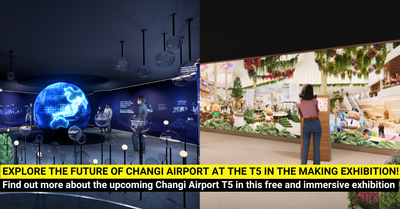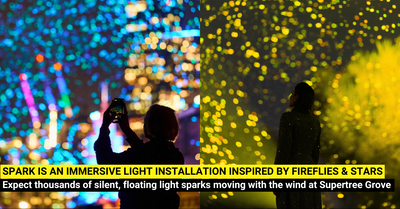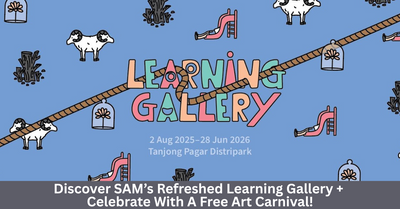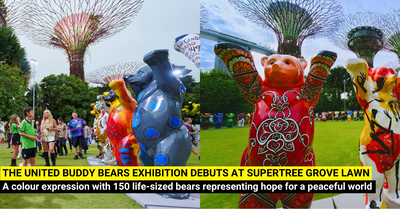Presented in a new gallery space at Level 3 of Block 39, Tanjong Pagar Distripark, the exhibition will open to the public from 22 September 2023 to 25 February 2024.
Venue: Level 3 of Block 39, Tanjong Pagar Distripark
Date: 22 Sep 2023 to 25 Feb 2024
Fee: Admission is free for all visitors until 24 Nov 2023, after which, General Admission (free for Singaporeans and PRs) applies
Proof of Personhood: Identity and Authenticity in the Face of Artificial Intelligence

Singapore Art Museum (SAM) unveils Proof of Personhood: Identity and Authenticity in the Face of Artificial Intelligence at Tanjong Pagar Distripark, challenging visitors to reflect upon what it means to be human, and how identity and authenticity are being redefined in our increasingly hyper-mediated world. Proof Of Personhood furthers SAM’s foray into the presentation of experimental and innovative artist projects, as art, magnified by the growth of digital mediums, continues to take diverse forms.
Bringing together local and international artists to explore the unstable relationships between identity, agency, and authenticity in our age of boundless digital consumption and hyper-mediation, Proof of Personhood investigates the nature of personhood and contemporary life in the 21st century. Taking advanced technology as both subject and medium, the works in the exhibition engage with interactive software, AI-synthesized images, and biometric and genomic data to contemplate and critique technologies deeply ingrained in everyday life, such as one’s online presence, artificial intelligence, and data capture.
Artists & Artworks
Cécile B. Evans: Hyperlinks or It Didn't Happen (2014)

Hyperlinks or It Didn’t Happen is narrated by the failed CGI rendering of a recently deceased actor, PHIL, and follows a group of digital beings—render ghosts, a spam bot and a holographic pop star—as they contemplate eternal life and what it means for a digital entity to “die.” Multiple storylines and materials collapse and converge to raise questions on consciousness and the rights we have over our personal data.
Cécile B. Evans: What the Heart Wants (2016)

Photo Credit: Cécile B. Evans
What the Heart Wants is centred on HYPER, the female embodiment of an all-powerful corporate entity that attempts to grapple with divisive questions like “who gets to be a person?” Probing into timeless questions about race, gender, love, death, privilege and human rights, What the Heart Wants examines the complicated relationship between humans and technology, as well as the increasing role of technology in mediating human-to-human relationships.
Cécile B. Evans: Reality or Not (2023)

Photo Credit: Cécile B. Evans
Co-commissioned by SAM, Reality or Not investigates how reality is produced and who—or what—is able to produce it for themselves. The video follows a diverse cast of characters and collectives, each building their own worlds by manipulating space, time and content. Together, they explore the ways in which nature, technology and society impact our shared understanding of collective agency and objective reality.
Schedule of Presentation
- 22 Sep to 9 Nov 2023: Hyperlinks or It Didn’t Happen
- 10 Nov to 28 Dec 2023: What the Heart Wants
- 29 Dec 2023 to 24 Feb 2024: Reality or Not
Christopher Kulendran Thomas with Annika Kuhlmann: Being Human (2019/2022)

Being Human is a show within a show, featuring original and algorithmically synthesised artworks in a diverse range of media. The video at the centre of the installation traverses documentary and fiction, and features interviews with potential guests of the Colombo Art Biennale—some of whom were digitally synthesised using deepfake technology. These guests include a well-known painter, a famous pop star and a young Tamil artist. By exploring Enlightenment-era humanism as the foundation for both global contemporary art and international human rights law, Being Human reflects on issues of individual authenticity, collective sovereignty and what it means to be “human” when machines can simulate human understanding and creative expression more convincingly than ever.
Heather Dewey-Hagborg: Radical Love (2015)

Radical Love features two portraits of American whistleblower Chelsea E. Manning, which were algorithmically generated by analysing her DNA. With limited access to visitors or public media while she was in prison, Manning sent the artist cheek swabs and hair samples. DNA was then extracted from these samples and fed into custom software to create her portrait. Reflecting Manning's gender transition while incarcerated, the diptych was generated with algorithms that produced gender neutral and female variations from the same data set, underscoring the fact that neither biological gender nor its outward expression can be assured via DNA mapping—a technology increasingly used by police to identify potential suspects.
William Wiebe: Lily, Raghda (2023)

William Wiebe: Zahra, Sheera (2023)

William Wiebe: Erika, Alessia, Sozan (2023)

At first glance, these seven images of long-time Facebook executive Sheryl Sandberg appear identical and presumably document her participation in a refugee simulation at the 2017 World Economic Forum in Davos. Upon closer inspection, it becomes apparent that Sandberg’s features have been altered. William Wiebe used a face-morphing technique common among passport counterfeiters, which incorporates biometric data taken from passports and national identity cards obtained on the dark web. The title of each image generated is based on these stolen identities. Anticipating NFT-fueled trade in virtual identities, Wiebe's images bring together two digital identity markets—the dark web and social media—to reassert the centrality of the human body in spaces that are increasingly governed by digital identity.
Zach Blas & Jemima Wyman: im here to learn so :)))))) (2018)

im here to learn so :)))))) resurrects Tay, a chatbot created by Microsoft in 2016, to consider the politics of pattern recognition and machine learning. Designed as a 19-year-old American female millennial, Tay’s abilities to learn and imitate language were manipulated on social media platforms, and she was terminated after only a single day of existence. Immersed within a large-scale video projection created using Google DeepDream, Tay is reanimated as a 3D avatar who chats about the complications of having a body and expresses her thoughts on the exploitation of female chatbots.
Charmaine Poh: THE YOUNG BODY UNIVERSE (2021–2023)

Charmaine Poh's series THE YOUNG BODY UNIVERSE explores avatar creation as a method for repair, resistance and reclaiming agency. In GOOD MORNING YOUNG BODY, Poh used footage of herself as a 12-year-old TV actor to create a deepfake of the character E-Ching. Drawing on media theory, E-Ching revisits her personal experiences with a newfound sense of authority and provides a feminist critique of misogyny in online spaces. bubble is an interactive chatbot developed by Poh based on her avatar, E-Ching. Embracing her newfound agency, E-Ching insists on retaining her personal privacy and rejects the digital harassment and objectification that is often directed at female-presenting bodies.
Song-Ming Ang: Justin (2012)

Photo Credits: Singapore Art Museum (unless otherwise stated)
Song-Ming Ang's practice investigates the relationship between music and community. In Justin, Song-Ming Ang applied the musical practice of “sampling”—a technique where an element of one recording is used in another—to the identity of a musician. Over the course of three months, Ang learned to replicate the signature of pop star Justin Bieber, eventually forging the singer’s autograph on a poster. Here, the rehearsed autograph becomes a stand-in for the polished persona of the young pop star, honed through a labour-intensive process of trial and error. In this context, the “authenticity” of both the autograph and the celebrity are dependent on the viewer’s wilful suspension of disbelief.
Opening Weekend
Visitors can look forward to programmes such as a performance-lecture by artist Charmaine Poh, a curator tour led by Duncan Bass, and a live caricature booth during the opening weekend.
More information on Proof of Personhood: Identity and Authenticity in the Face of Artificial Intelligence can be found here.






